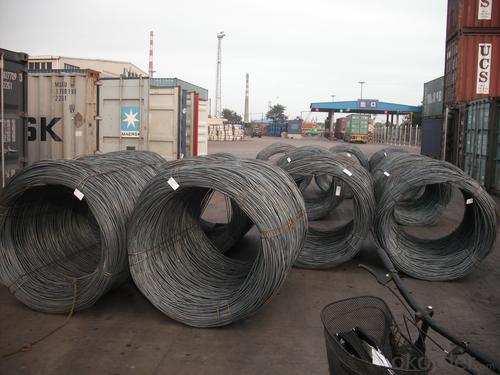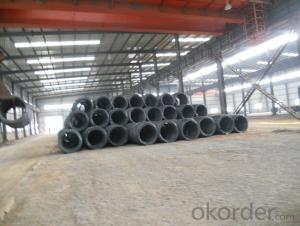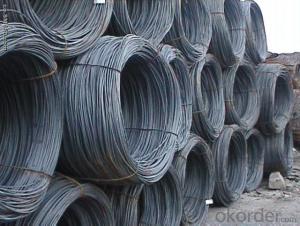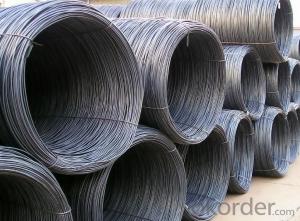Hot Rolled Steel Coil Carbon Wire Rod
- Loading Port:
- China Main Port
- Payment Terms:
- TT or LC
- Min Order Qty:
- -
- Supply Capability:
- -
OKorder Service Pledge
OKorder Financial Service
You Might Also Like
Product Description:
OKorder is offering Wire Rod at great prices with worldwide shipping. Our supplier is a world-class manufacturer of steel, with our products utilized the world over. OKorder annually supplies products to European, North American and Asian markets. We provide quotations within 24 hours of receiving an inquiry and guarantee competitive prices.
Product Applications:
After hot-rolled the products shaped into coil and delivery as finished product, including round, square, rectangular, hexagonal and so on. Since most of the products are round, it is generally called wire rod. Carbon steel wire rod is widely used in construction and manufacturing. Carbon steel wire rod is mainly used for reinforcement of reinforced concrete and welded structure or reprocessed (roberts , nail, etc.) materials, especially used to produce wire drawing, welding electrode, nails, spring, electronic, precise machinery parts and so on.
Product Advantages:
OKorder's Wire Rod are durable, strong, and resist corrosion.
Main Product Features:
· Premium quality
· Prompt delivery & seaworthy packing (30 days after receiving deposit)
· Corrosion resistance
· Can be recycled and reused
· Mill test certification
· Professional Service
· Competitive pricing
Product Specifications:
Steel Grade: Q195/235, SAE1006-1018B Standard: ASTM, GB
Diameter: 5.5mm, 6.5mm, 7mm,8mm,9mm,10mm,12mm,14mm
Type: in coil, coil weight around 2MT Alloy or Not: Alloy
Surface: round, no twisted, light and smooth Chemical Composition: (Please kindly find our chemistry of our material based on Q195、Q235A and Q235B as below for your information)
Packaging & Delivery of Carbon Steel Wire Rod:
Packaging Detail: products are packed in coil, each coil weight around 2 MT, and then shipped by container or bulk vessel
Delivery Detail: within 45 days after received deposit or LC.
Label: to be specified by customer, generally, each bundle has 1-2 labels
Trade terms: FOB, CFR, CIF
Carbon Steel Wire Rod on Port
Carbon Steel Wire Rod in Container
Trademark | Rank | Chemical composition (quality score) % | |||||
C | Si | Mn | S | P | |||
| ≤ |
| ≤ | ≤ | |||
Q195 |
| 0.06-0.12 | 0.30 | 0.25 | 0.050 | 0.045 | |
Trademark | Rank | Pulling Test | |||||
Bend PointΔs/Mpa | Tensile Strength | Elongation Ratioδ5% | |||||
Thickness (Diameter) /MM | Thickness (Diameter) /MM | ||||||
≤16 | 16-40 | ≤16 | 16-40 | ||||
≥ | ≥ | ||||||
Q195 |
| 195 | 185 | 315-390 | 33 | 32 | |
FAQ:
Q1: Why buy Materials & Equipment from OKorder.com?
A1: All products offered byOKorder.com are carefully selected from China's most reliable manufacturing enterprises. Through its ISO certifications, OKorder.com adheres to the highest standards and a commitment to supply chain safety and customer satisfaction.
Q2: How do we guarantee the quality of our products?
A2: We have established an advanced quality management system which conducts strict quality tests at every step, from raw materials to the final product. At the same time, we provide extensive follow-up service assurances as required.
Q3: Can stainless steel rust?
A3: Stainless does not "rust" as you think of regular steel rusting with a red oxide on the surface that flakes off. If you see red rust it is probably due to some iron particles that have contaminated the surface of the stainless steel and it is these iron particles that are rusting. Look at the source of the rusting and see if you can remove it from the surface.
Images:
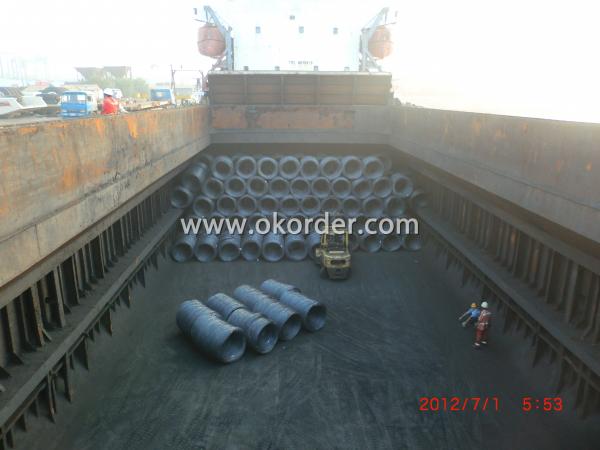
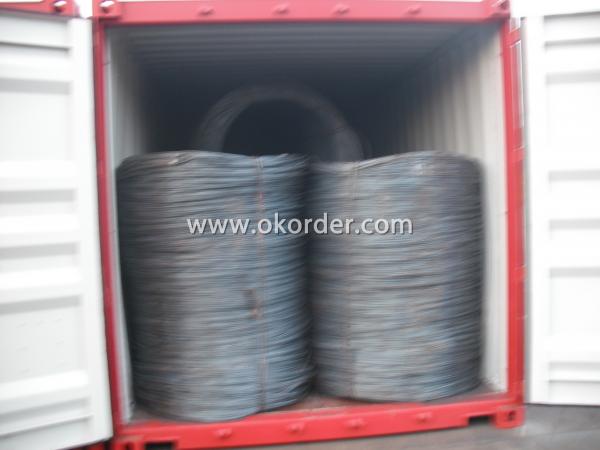
- Q: How does the tensile strength of steel wire rod vary with different wire drawing processes?
- The tensile strength of steel wire rod can vary significantly depending on the specific wire drawing process used. Wire drawing is a metalworking process that involves reducing the diameter of a wire by pulling it through a series of dies. Different wire drawing processes, such as cold drawing, hot drawing, and intermediate drawing, can have different effects on the tensile strength of the steel wire rod. During cold drawing, the steel wire rod is pulled through a die at room temperature. This process can increase the tensile strength of the wire rod significantly. Cold drawing aligns the metal's crystalline structure, which results in increased strength and hardness of the wire. The wire is also likely to have a smooth and uniform surface finish due to the cold drawing process. Hot drawing, on the other hand, involves pulling the steel wire rod through a die at elevated temperatures. This process can also increase the tensile strength of the wire rod, but to a lesser extent compared to cold drawing. Hot drawing allows for greater plastic deformation of the steel, resulting in improved ductility and reduced brittleness. The wire produced through hot drawing may have a rougher surface finish due to the higher temperatures involved. Intermediate drawing is a combination of both cold and hot drawing processes. In this process, the steel wire rod is initially subjected to hot drawing and then cold drawing. This combination allows for greater control over the mechanical properties of the wire, including tensile strength. Intermediate drawing can result in a wire with improved strength and ductility, as the hot drawing process improves plastic deformation and the cold drawing process aligns the crystalline structure. In summary, the tensile strength of steel wire rod can vary with different wire drawing processes. Cold drawing generally results in the highest increase in tensile strength due to the alignment of the crystalline structure. Hot drawing and intermediate drawing processes also increase strength but to a lesser extent, while providing other benefits such as improved ductility and reduced brittleness. The specific wire drawing process chosen depends on the desired mechanical properties and surface finish of the wire.
- Q: How is steel wire rod used in the manufacturing of wire forms for packaging?
- Steel wire rod is used in the manufacturing of wire forms for packaging as it provides the necessary strength and durability required for secure packaging. It is commonly used to create wire frames, hooks, clips, and other components that hold packaging materials together or provide support. The steel wire rod is bent, shaped, and formed into various structures to create customized wire forms that can securely hold and protect products during transportation and storage.
- Q: How is steel wire rod classified based on its carbon content?
- There are three main categories in which steel wire rod can be classified, based on its carbon content: low carbon wire rod, medium carbon wire rod, and high carbon wire rod. Low carbon wire rod is typically characterized by carbon levels ranging from 0.05% to 0.15%. It is known for its high ductility and excellent formability. This type of wire rod is commonly used in applications that require flexibility and bending, such as in the production of fencing wires, nails, and construction materials. Medium carbon wire rod, on the other hand, contains carbon levels ranging from 0.15% to 0.45%. It possesses higher strength and hardness compared to low carbon wire rod. Medium carbon wire rod finds its use in applications that demand both strength and flexibility, such as in the manufacturing of automotive parts, springs, and certain types of fasteners. Lastly, high carbon wire rod has carbon levels ranging from 0.45% to 0.85%. It is renowned for its exceptional strength and hardness. High carbon wire rod is typically utilized in applications that require maximum strength, such as in the production of high-tensile wires used for suspension bridges, pre-stressed concrete structures, and wire ropes used in heavy machinery. The classification of steel wire rod based on its carbon content enables manufacturers and consumers to select the appropriate grade of wire rod that suits their specific needs. This consideration takes into account factors like strength, flexibility, and durability requirements.
- Q: How is steel wire rod used in the production of suspension springs for industrial machinery?
- Steel wire rod is used in the production of suspension springs for industrial machinery as it provides the necessary strength and durability required to withstand heavy loads and provide stable suspension. The wire rod is formed into coils and then undergoes a series of processes such as heat treatment and cold working to enhance its mechanical properties. These springs are then used in the suspension systems of machinery to absorb shocks and vibrations, ensuring smooth operation and enhanced safety.
- Q: What are the different types of steel wire rod processing equipment?
- There are several types of steel wire rod processing equipment, including wire drawing machines, wire straightening and cutting machines, wire mesh welding machines, and wire bending machines. Each of these equipment serves a specific purpose in the production and processing of steel wire rods, such as enhancing the wire's strength, straightening and cutting it to desired lengths, welding wires to create mesh structures, or bending them into various shapes.
- Q: How is steel wire rod used in the manufacturing of wire forms for filtration systems?
- Steel wire rod is an essential component in the manufacturing of wire forms for filtration systems. The wire rod serves as the primary raw material for producing wires of various diameters and strengths, which are then shaped into specific forms used in filtration systems. To begin the manufacturing process, the steel wire rod is first carefully selected based on its composition, mechanical properties, and desired characteristics. This ensures that the wire rod is suitable for the specific filtration system requirements, such as resistance to corrosion, high tensile strength, and durability. Once the appropriate steel wire rod is chosen, it undergoes a series of manufacturing steps to transform it into wire forms for filtration systems. The wire rod is first cleaned and descaled to remove any impurities or surface contaminants that may affect its performance. It is then heated to a specific temperature to make it more malleable and easier to shape. The heated wire rod is then passed through a series of dies or molds, which give it the desired shape and dimensions for the wire forms used in filtration systems. The wire may be drawn through multiple dies to achieve the desired diameter and strength required for effective filtration. After shaping, the wire forms go through additional processes like annealing, which involves heating and slowly cooling the wire to relieve any stresses and improve its ductility. This step ensures that the wire forms can withstand the demands of filtration systems, such as high pressure or constant use. Once the wire forms are manufactured, they can be further processed or assembled into complete filtration systems. For example, the wire forms may be welded or joined together to create mesh screens or filter elements, which are then integrated into the overall filtration system design. Overall, steel wire rod plays a crucial role in the manufacturing of wire forms for filtration systems. Its versatility, strength, and ability to be shaped and transformed into various forms make it an ideal material for producing wires that meet the specific requirements of filtration systems. Whether it's for removing contaminants from liquids or gases, steel wire rod ensures the durability and effectiveness of filtration systems in a wide range of industries.
- Q: What are the different impact testing methods for steel wire rod?
- To evaluate the mechanical properties of steel wire rods, there are multiple impact testing methods available. These methods are essential in determining the wire rods' ability to withstand sudden impact or shock loading, which is crucial in industries like construction, automotive, and aerospace. Some commonly used impact testing methods for steel wire rods are as follows: 1. Charpy Impact Test: This method involves striking a notched or V-notch specimen with a pendulum hammer to measure the energy absorbed during fracture. It provides a measure of the material's toughness and is widely preferred for its simplicity and ease of implementation. The results are typically reported in joules. 2. Izod Impact Test: Similar to the Charpy test, the Izod test also measures the energy absorbed during fracture. However, in this method, the specimen is clamped vertically, and the pendulum strikes it on the opposite side of the notch. This test assesses the material's resistance to sudden impact. 3. Drop Weight Test: This method involves dropping a weight from a specified height onto a wire rod specimen. The energy absorbed during fracture is measured, allowing for the evaluation of the material's impact resistance under specific conditions. 4. Dynamic Tear Test: This test evaluates the fracture toughness of steel wire rods by measuring the energy required to propagate a pre-existing crack through the specimen. A load is applied to the specimen using either a pendulum or a hydraulic system, and the crack propagation is monitored. 5. Ballistic Pendulum Test: This method determines the velocity of a small projectile before and after it strikes the wire rod specimen. By measuring the change in velocity, the impact resistance of the material can be evaluated. This test is commonly used for high-strength steel wire rods. Each impact testing method has its own strengths and limitations, and the selection of the appropriate method depends on factors such as the specific application, material properties, and test requirements. It is crucial to choose a testing method that accurately reflects the intended use of the steel wire rod, ensuring its performance and reliability in real-world scenarios.
- Q: What are the typical applications of steel wire rod?
- Steel wire rod is a versatile material that finds its application in various industries. Some of the typical applications of steel wire rod include: 1. Construction: Steel wire rod is commonly used in construction applications such as reinforcing concrete structures. It provides strength and durability to the construction materials, making them more resistant to cracking and bending. 2. Manufacturing: Steel wire rod is extensively utilized in the manufacturing sector for producing a wide range of products. It is used in the production of nails, screws, springs, cables, ropes, wire mesh, and various other hardware and industrial products. 3. Automotive industry: Steel wire rod is widely used in the automotive industry for manufacturing components like suspension springs, seat springs, wire harnesses, and tire reinforcement. Its high strength and flexibility make it an ideal choice for these applications. 4. Electrical industry: Steel wire rod is used in the electrical industry for producing cables and wires. It provides excellent conductivity and durability, making it suitable for transmitting electric power or signals efficiently. 5. Agriculture: Steel wire rod is utilized in the agricultural sector for various purposes. It is used in fencing, trellis systems, and vineyard wires to provide support and protection to crops and livestock. It is also used in manufacturing agricultural equipment like wire fencing, gates, and animal enclosures. 6. Packaging and fastening: Steel wire rod is employed in the packaging industry for manufacturing wire for packaging purposes, such as baling wire for securing bundles or tying products together. It is also used in fastening applications like wire ties and clips. 7. Furniture and appliances: Steel wire rod is used in the production of furniture and appliances, such as wire shelves, racks, and frames. It provides strength and stability to these products, making them durable and long-lasting. Overall, steel wire rod has a wide range of applications due to its excellent strength, flexibility, and durability. Its versatility makes it an essential material in various industries, contributing to the development and improvement of numerous products and structures.
- Q: How is steel wire rod used in the production of mesh fencing?
- Mesh fencing production relies heavily on steel wire rod, which serves as the primary material for creating the individual wires that are woven or welded together to form the desired mesh pattern. To initiate the manufacturing process, the steel wire rod undergoes a series of mechanical operations, including drawing and annealing, in order to enhance its strength and flexibility. This process guarantees that the wire is robust and capable of enduring external forces and environmental conditions. After the wire rod is processed, it is then fed into a machine that transforms it into individual wires with the desired diameter. These wires are subsequently woven or welded together to produce the familiar mesh pattern found in fencing. Woven mesh fencing is crafted by interlocking wires in a crisscross pattern, resulting in a resilient and adaptable structure. It is frequently employed in agricultural applications, such as livestock enclosures or perimeter fencing. Conversely, welded mesh fencing is created by welding the wires at their intersection points, producing a rigid and sturdy mesh structure. This type of fencing is commonly used in industrial settings, construction sites, or for security purposes, as it provides exceptional strength and durability. In both cases, the steel wire rod plays a vital role as the foundational raw material for mesh fencing. It ensures that the fencing can withstand a variety of external factors, such as weather conditions, impacts, and pressure. Furthermore, the steel wire rod is often galvanized or coated with protective materials to enhance its resistance to corrosion, thus increasing the longevity and durability of the mesh fencing.
- Q: How is steel wire rod used in the manufacturing of wire forms for garage doors?
- The manufacturing process of wire forms for garage doors heavily relies on steel wire rod. This essential component acts as the primary material for producing sturdy and long-lasting wires used in the construction of garage doors. To begin with, the selection of steel wire rod is a meticulous process that considers specific qualities like strength, flexibility, and resistance to corrosion. These characteristics ensure that the wires created from the rod can endure the daily tension and stress experienced by garage doors. The manufacturing process commences with the introduction of the steel wire rod into a wire drawing machine. This machine progressively elongates the rod, decreasing its diameter while increasing its length. By repeating this process, the wire is shaped to the desired diameter and length suitable for wire forms. Once the wire has been drawn, it is then molded into various forms crucial for the proper functioning of the garage door. For example, it can be bent or coiled to form springs that provide the necessary counterbalance for the door's weight. These springs are vital to ensure the smooth operation and correct balance of the garage door. Moreover, the wire can also be shaped into cables or tracks that guide the movement of the garage door along its designated path. These cables and tracks guarantee a secure and seamless movement of the door, minimizing any potential damage or accidents. Additionally, steel wire rod is utilized in the creation of reinforcement bars, which add strength and stability to different components of the garage door. These reinforcement bars are strategically placed in areas prone to stress and strain, such as hinges and tracks, to prevent deformation or failure. In conclusion, steel wire rod plays an indispensable role in manufacturing wire forms for garage doors. Its strength, flexibility, and resistance to corrosion make it the ideal material for producing wires capable of meeting the demanding requirements of garage door operation.
Send your message to us
Hot Rolled Steel Coil Carbon Wire Rod
- Loading Port:
- China Main Port
- Payment Terms:
- TT or LC
- Min Order Qty:
- -
- Supply Capability:
- -
OKorder Service Pledge
OKorder Financial Service
Similar products
Hot products
Hot Searches
Related keywords



